Foraging and steeping wild nettle leaves for tea can be a delightful adventure. Start by finding moist woodlands or disturbed areas where nettles thrive. Wear gloves to avoid stings and harvest the top few inches of young shoots in early spring for the best flavor. After rinsing the leaves, you can steep 1 to 2 teaspoons in hot water for 5 to 10 minutes. Enjoy it plain or with lemon and honey. Nettle tea's rich vitamins and minerals offer numerous health benefits, making your efforts worthwhile. There's much more to explore about this versatile plant and its uses.
Understanding Wild Nettles

Wild nettles, often overlooked in gardens and meadows, are fascinating plants with a rich history and numerous benefits. You might be surprised to learn that these plants, known scientifically as Urtica dioica, have been used for centuries in traditional medicine and cuisine. Their leaves are packed with nutrients, including vitamins A, C, K, and several B vitamins, as well as minerals like iron and calcium.
When you encounter wild nettles, you'll notice their serrated leaves and tiny, hair-like structures that can sting if touched. But don't let that deter you! Once cooked or steeped in hot water, nettles lose their sting and transform into a delicious, nutritious ingredient.
Understanding the plant's lifecycle is essential for foraging. Nettles thrive in moist, nutrient-rich soil and typically emerge in spring. You'll find them in abundance near water sources or in shaded areas.
Harvesting young leaves is the best way to enjoy their flavor and health benefits. Just remember to wear gloves while picking them!
Best Foraging Locations
When foraging for wild nettles, knowing where to look can make all the difference. These nutrient-rich plants thrive in specific environments, so targeting the right locations increases your chances of a successful harvest.
Here are some of the best places to find wild nettles:
- Moist Woodlands: Look near streams or damp areas, where nettles often grow in abundance.
- Roadside Edges: Check along country roads or paths, as nettles tend to flourish in disturbed soils.
- Abandoned Lots: Explore vacant lots or fields that haven't been maintained, where nettles can establish a strong presence.
- Garden Borders: If you have gardens or know of others, nettles sometimes pop up along the edges or in compost piles.
Always remember to respect nature and foraging guidelines. Avoid overharvesting, and make sure you're foraging in areas free from pesticides or pollutants.
When you know where to look, you'll not only enjoy the adventure of foraging but also come away with a bounty of delicious nettles for your tea.
Happy foraging!
Identifying Nettle Plants

When you're out foraging for nettles, knowing how to identify them is essential.
Look for their distinct, serrated leaves and remember that they thrive in moist, nutrient-rich environments.
Once you've spotted them, you'll want to use the right harvesting techniques to guarantee you gather safely and sustainably.
Appearance of Nettle Leaves
Nettle leaves can easily be identified by their distinctive heart-shaped structure and serrated edges. These features make them stand out in the wild, so you won't have trouble recognizing them once you know what to look for.
The leaves typically grow in pairs opposite each other on the stem, creating a lush green appearance.
When identifying nettle leaves, consider these key characteristics:
- Color: Bright green, with a slightly glossy surface.
- Texture: Fine hairs cover the leaves, which can sting if touched, so be cautious!
- Size: Leaves usually range from 3 to 7 inches long, depending on the plant's maturity.
- Shape: The heart-like shape is most pronounced near the base of the leaf, tapering to a point at the tip.
Preferred Growing Conditions
Successful foraging often hinges on understanding the preferred growing conditions of wild plants, and nettles thrive in specific environments.
You'll typically find nettles in moist, nutrient-rich soil, often near waterways, ditches, or in shaded woodland areas. They prefer areas with partial to full sun but can tolerate some shade.
When looking for nettles, pay attention to their companions. They often grow alongside other moisture-loving plants, such as wild garlic or various herbs. Nettles flourish in disturbed soils, so check areas that have been recently cleared or where construction has occurred.
The best time to spot them is in spring, right after the frost has passed but before they start to flower. This is when the leaves are most tender and flavorful.
They usually grow as perennials, meaning they'll return year after year, so once you find a patch, you may revisit it in the following seasons.
Keep in mind that nettles can spread quickly, so be cautious about over-foraging. By understanding their preferred growing conditions, you'll be more successful in locating these nutritious plants for your tea.
Harvesting Techniques Explained
Identifying nettle plants can be a rewarding experience, especially when you know what to look for. When you're out foraging, keep an eye out for these key characteristics to guarantee you've found the right plant:
- Leaves: Nettles have serrated, heart-shaped leaves that grow in pairs along the stem. They're typically a vibrant green.
- Stems: The stems are square-shaped and can be quite hairy. Be cautious, as they can sting when touched.
- Height: Nettle plants usually grow between 2 to 4 feet tall, making them relatively easy to spot in the wild.
- Flowers: Look for small, greenish flowers that grow in clusters along the stem. These usually appear during the late spring to early summer.
When you confidently identify nettles, you'll be ready to harvest them for tea. Just remember to wear gloves while handling them to avoid the sting.
Once you've pinpointed a patch, you can carefully cut the tops of the plants, ensuring you leave enough behind for regrowth.
Happy foraging!
Harvesting Techniques
When you're ready to harvest nettles, timing is key for the best flavor and potency.
Make sure you take safety precautions, as these plants can sting if handled improperly.
You'll also want to gather the right tools to make the process smooth and efficient.
Best Harvesting Time
The best time to harvest wild nettle leaves is during the early spring, typically from March to May, before the plants start to flower. This is when the leaves are young, tender, and packed with nutrients, making them perfect for your nettle tea.
When you're out foraging, pay attention to the following tips for ideal harvesting:
- Look for young shoots: Focus on the top few inches of the plant, as these tender leaves yield the best flavor and potency.
- Harvest in dry weather: Try to pick nettles after a dry spell, as wet leaves can be tougher and harder to handle.
- Use gloves: The tiny hairs on nettle leaves can sting, so protect your hands while you harvest.
- Limit your harvest: Only take what you need, leaving enough plants behind to thrive and regenerate for future seasons.
Safety Precautions
While foraging for wild nettles can be a rewarding experience, taking the right safety precautions is essential to avoid injury and secure a successful harvest.
First, always wear protective gloves when handling nettles. Their tiny stinging hairs can deliver a painful sting that you'll want to avoid. Long sleeves and pants can also minimize skin exposure, particularly if you're foraging in thick patches.
Next, confirm you identify nettles correctly. Mistaking them for other plants can lead to ingesting something harmful. Familiarize yourself with their characteristics—heart-shaped leaves and serrated edges—before you head out. It's wise to forage in areas free from pesticides or pollutants, as these chemicals can contaminate the plants.
Be mindful of your surroundings. Look out for any wildlife or hazardous terrain that could pose risks while you're busy harvesting. If you're allergic to other plants, stay cautious, as you may have a similar reaction to nettles.
Lastly, make certain you're respectful of the environment. Only harvest what you need, allowing the plants to thrive for future foragers.
Tools Needed
To successfully harvest wild nettles, you'll need a few essential tools to make the process efficient and safe.
These tools not only protect you from the nettles' sting but also help guarantee you gather the leaves properly.
Here's what you should have on hand:
- Gardening gloves: Protect your hands from stinging while you handle the nettles.
- Sharp scissors or garden shears: Use these to cut the nettles cleanly, ensuring you take only the top few inches of the plant.
- Reusable bag or basket: This will help you collect and transport the harvested nettles without damaging them.
- Long-sleeved clothing: Wearing long sleeves will provide an extra layer of protection against any accidental contact with stinging hairs.
With these tools in your arsenal, you're ready to head out and gather your wild nettles safely.
Remember to harvest responsibly, taking care not to overharvest any single area.
Safety Precautions
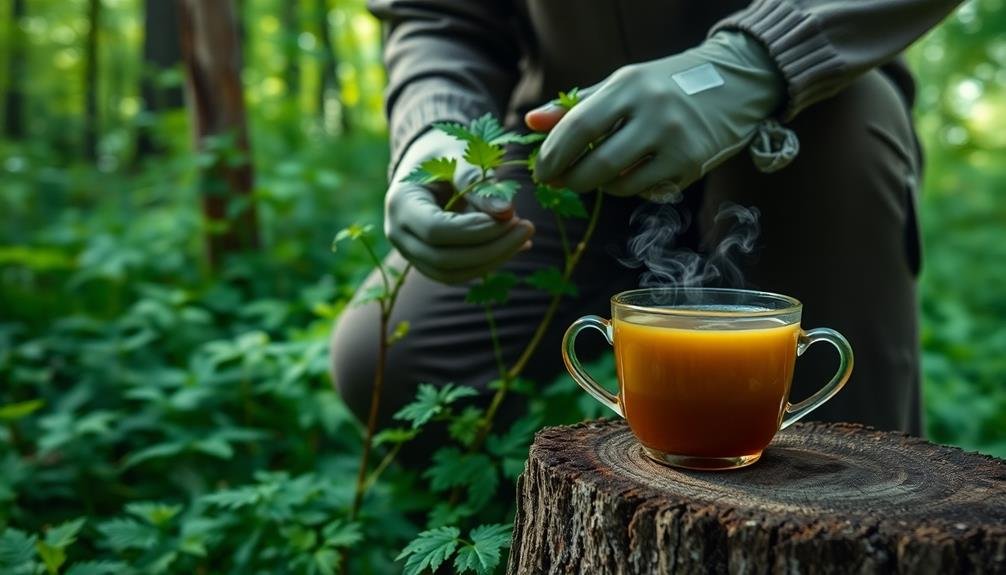
Understanding safety precautions is essential when it comes to enjoying wild nettle leaf tea. First, make sure you correctly identify the plant. Wild nettles (Urtica dioica) have distinctive serrated leaves and tiny stinging hairs. If you're unsure, consult a reliable field guide or an expert before foraging.
Next, harvest nettles from areas free of pesticides, herbicides, or pollutants. Avoid roadside patches or places near industrial sites, as these could contaminate your harvest. Always wear gloves when handling fresh nettles to prevent skin irritation from their stinging hairs.
Once you've collected your nettles, wash them thoroughly to remove dirt and any insects. If you're pregnant, nursing, or taking medications, consult your healthcare professional before consuming nettle tea, as it may interact with certain medications or conditions.
Lastly, be mindful of allergies. If you have a history of allergic reactions to plants in the same family, it's best to err on the side of caution.
Preparing Nettle Leaves
Preparing nettle leaves is a straightforward process that can enhance your tea experience. Once you've foraged fresh nettles, it's essential to handle them correctly to maximize their flavor and benefits. Here's how you can prepare your nettle leaves:
- Wear gloves: Protect your hands from stinging by wearing gloves while handling the leaves.
- Rinse thoroughly: Wash the nettles under cool running water to remove dirt and any insects.
- Remove stems: Using kitchen scissors, snip off the leaves from the stems. You can discard the stems as they're less desirable for tea.
- Chop or tear: Depending on your preference, chop or tear the leaves into smaller pieces. This can help release more flavor during steeping.
Once prepared, the leaves can be used right away or dried for later use.
Remember, treating nettle leaves properly not only prevents stings but also guarantees you're making the most of their nutritious properties.
Enjoy the process and look forward to a delightful cup of nettle tea!
Steeping Methods

Now that you've prepared your nettle leaves, it's time to explore how you can steep them to release their full flavor and benefits.
You can try traditional techniques, experiment with a cold infusion, or use quick brew tips to suit your schedule.
Each method has its perks, so let's find the one that works best for you.
Traditional Steeping Techniques
When it comes to brewing wild nettle leaf tea, traditional steeping techniques can make all the difference in flavor and potency. To guarantee you get the most out of your nettle leaves, follow these simple yet effective methods.
First, start with high-quality dried nettle leaves, as fresh ones might be too strong for some. Use about 1 to 2 teaspoons of dried leaves per cup of water. Next, bring your water to a gentle boil, then let it cool for about 30 seconds before pouring it over the leaves. This helps preserve the delicate nutrients and enhances the taste.
Here are some key traditional steeping techniques to remember:
- Steep Time: Allow your tea to steep for 5 to 10 minutes, depending on your taste preference.
- Cover Your Cup: Use a lid or a small plate to cover your cup while steeping; this retains heat and essential oils.
- Strain Well: After steeping, strain the leaves thoroughly to avoid bitterness.
- Experiment: Don't hesitate to mix in other herbs or flavors like lemon or honey for a personalized touch.
Enjoy your deliciously brewed nettle leaf tea!
Cold Infusion Method
For those hot summer days or when you crave an invigorating drink, the cold infusion method for brewing wild nettle leaf tea offers a delightful alternative. This technique allows you to extract the nutrients and flavor from nettles without the heat, making it a revitalizing choice.
To prepare cold infusion tea, simply follow these steps:
- Place 1-2 tablespoons of dried wild nettle leaves in a jar or pitcher.
- Add 4 cups of cold water.
- Let it steep in the refrigerator for 4-8 hours, depending on how strong you want the flavor.
Here's a quick reference table to help you understand the steeping times and flavor intensity:
| Steeping Time | Flavor Strength | Ideal Use |
|---|---|---|
| 4 hours | Mild | Revitalizing drink |
| 6 hours | Medium | Light infusion |
| 8 hours | Strong | Concentrated brew |
Once it's ready, strain the leaves, and enjoy your chilled nettle tea. You can sip it plain or add a splash of lemon for a zesty twist!
Quick Brew Tips
Frequently brewing wild nettle leaf tea can be a quick and enjoyable process when you know the right steeping methods.
Whether you prefer a robust flavor or something lighter, these tips will help you get the most out of your nettle leaves.
- Use Fresh Leaves: Freshly harvested nettle leaves yield a more vibrant flavor. If you can, gather them just before brewing.
- Water Temperature: Aim for water just below boiling (around 190°F or 88°C). This temperature extracts the best flavors without scorching the leaves.
- Steeping Time: Steep for 5 to 10 minutes, depending on your taste preference. A shorter steep offers a milder flavor, while a longer steep brings out more depth.
- Cover Your Cup: Use a lid or plate to cover your steeping vessel. This traps heat and essential oils, enhancing the tea's overall flavor.
Flavor Pairings
Wild nettle leaf tea boasts a unique herbal flavor that can be beautifully enhanced through thoughtful pairings. When you're preparing your nettle tea, consider adding a slice of fresh lemon or a splash of honey. The bright acidity of the lemon cuts through the earthiness of the nettle, creating an invigorating balance, while honey adds a touch of sweetness that complements its natural flavors.
If you're feeling adventurous, try blending your nettle tea with other herbal teas like peppermint or chamomile. Peppermint brings a cooling sensation, perfect for a warm day, while chamomile's gentle sweetness pairs well with the robust nature of nettles. You might also enjoy adding a sprig of fresh mint or a few crushed ginger slices for an extra kick.
For those who prefer a more savory approach, consider steeping your nettle tea with garlic or onion. This combination can create a delightful broth, ideal for sipping on cool evenings.
Nutritional Benefits

Nettle leaf tea isn't just a flavorful beverage; it also packs a powerful nutritional punch. When you sip this herbal infusion, you're introducing a wealth of nutrients into your body that can support overall health.
Nettle leaves are rich in vitamins and minerals, making them an excellent addition to your wellness routine.
Here are some of the key nutritional benefits you can enjoy from nettle leaf tea:
- Vitamins A, C, and K: These essential vitamins support immune function, skin health, and bone strength.
- Iron: Nettle is a great source of iron, which helps in the production of red blood cells and can prevent anemia.
- Calcium: This mineral is crucial for maintaining strong bones and teeth, and nettle tea can contribute to your daily intake.
- Antioxidants: Nettle leaves contain powerful antioxidants that help combat oxidative stress and reduce inflammation in the body.
Storing Dried Nettle
Properly storing dried nettle is essential to maintain its flavor and nutritional benefits. First, make sure your nettle is completely dry before storing it. Any moisture can lead to mold, ruining your hard work.
Once dried, choose an airtight container, like a glass jar or a sealed plastic bag. This helps keep out air and moisture.
Keep your container in a cool, dark place away from direct sunlight. Heat and light can degrade the quality of your nettle over time. A pantry or a cupboard works well for this purpose.
Label your container with the date you harvested or dried the nettle. This way, you'll know how long it's been stored.
Dried nettle can last up to a year if stored properly, but for the best flavor and potency, try to use it within six months.
Creative Nettle Recipes

If you're looking to elevate your cooking game, incorporating nettle into your meals can add unique flavor and a nutritional boost. Nettle is rich in vitamins A, C, and K, making it not only tasty but also a powerhouse of nutrients.
Here are a few creative ways to use nettle in your kitchen:
- Nettle Soup: Sauté onions and garlic, then add fresh nettle leaves and vegetable broth. Blend until smooth for a comforting soup.
- Nettle Pesto: Blend nettle leaves with garlic, nuts, olive oil, and parmesan for a delicious twist on traditional pesto. Spread it on sandwiches or toss with pasta.
- Nettle Omelet: Whisk eggs and stir in chopped nettle leaves. Cook in a skillet for a nutritious breakfast that's packed with flavor.
- Nettle Chips: Toss nettle leaves with olive oil and seasoning, then bake until crispy for a healthy snack alternative.
These recipes showcase nettle's versatility, allowing you to enjoy its earthy flavor while reaping its health benefits.
Herbal Tea Blending Tips
Creating a delightful herbal tea blend can transform your tea-drinking experience into a flavorful journey. To get started, think about the flavors and benefits you want to achieve. Combine herbs that complement each other, balancing strong flavors with milder ones.
Here are some tips to guide your blending process:
| Flavor Profile | Herb Suggestions | Benefits |
|---|---|---|
| Floral | Chamomile, Lavender | Calming and soothing |
| Citrus | Lemon Balm, Lemongrass | Revitalizing and uplifting |
| Spicy | Ginger, Cinnamon | Warming and digestive aid |
| Earthy | Nettle, Dandelion | Nutrient-rich and detoxing |
| Minty | Peppermint, Spearmint | Invigorating and cooling |
When blending, start with a base herb, like nettle for its nutritional value, and add complementary herbs in small amounts. Experiment with proportions; a good rule of thumb is to use one part strong-flavored herbs to two parts milder ones. Don't hesitate to take notes as you go; this way, you can recreate your favorites and refine your blends for future enjoyment!
Seasonal Considerations

Seasonally, the availability and flavor of wild nettle leaves can vary, so it's important to contemplate when you'll be brewing your tea. The best time to forage for nettles is during the spring months, typically from March to June. During this season, the leaves are tender and packed with flavor, making them ideal for tea.
As the season progresses into summer, leaves can become tougher and more fibrous, which may impact the taste. By late summer and fall, the plants start to flower, and while you can still use the leaves, they won't be as flavorful. Winter is a time when nettles go dormant, so foraging isn't an option.
To maximize your nettle tea experience, consider these seasonal tips:
- Spring Harvest: Focus on young leaves for the best flavor.
- Summer Usage: Use leaves cautiously; opt for younger shoots.
- Fall Foraging: Collect any remaining leaves before the frost.
- Winter Preparation: Store dried nettle leaves for off-season use.
With these considerations in mind, you'll enjoy a delicious cup of wild nettle tea year-round!
Frequently Asked Questions
Can I Use Dried Nettle Leaves for Tea?
Yes, you can definitely use dried nettle leaves for tea. Just steep a few teaspoons in hot water for about ten minutes, and you'll enjoy a nutritious, herbal infusion loaded with health benefits.
How Long Does Nettle Tea Stay Fresh?
Nettle tea stays fresh for about 5 to 7 days in the refrigerator if you store it in an airtight container. If you freeze it, it can last up to 6 months. Enjoy your tea!
Is Nettle Tea Safe for Pregnant Women?
Nettle tea can be safe for pregnant women, but it's best to consult your healthcare provider first. They can help you understand any potential risks and guarantee it fits well with your pregnancy diet.
What Are the Effects of Nettle Tea on Blood Pressure?
Nettle tea can help manage blood pressure by acting as a natural diuretic, promoting urine production. However, it's crucial to monitor your levels, as individual responses may vary. Always consult your doctor before making changes.
Can I Mix Nettle Tea With Other Herbal Teas?
Absolutely, you can mix nettle tea with other herbal teas! Combining it with chamomile or mint enhances flavor and benefits. Just experiment to find your perfect blend, and enjoy the unique taste and effects of your creation.
In Summary
Incorporating wild nettle leaf tea into your routine can be a rewarding experience. By foraging responsibly and using the tips outlined, you'll enjoy the unique flavors and health benefits of this remarkable plant. Remember to respect nature and share your discoveries with friends. Whether you sip it solo or blend it with other herbs, nettle tea can elevate your herbal experience. So grab your basket, head outdoors, and start your foraging adventure today!

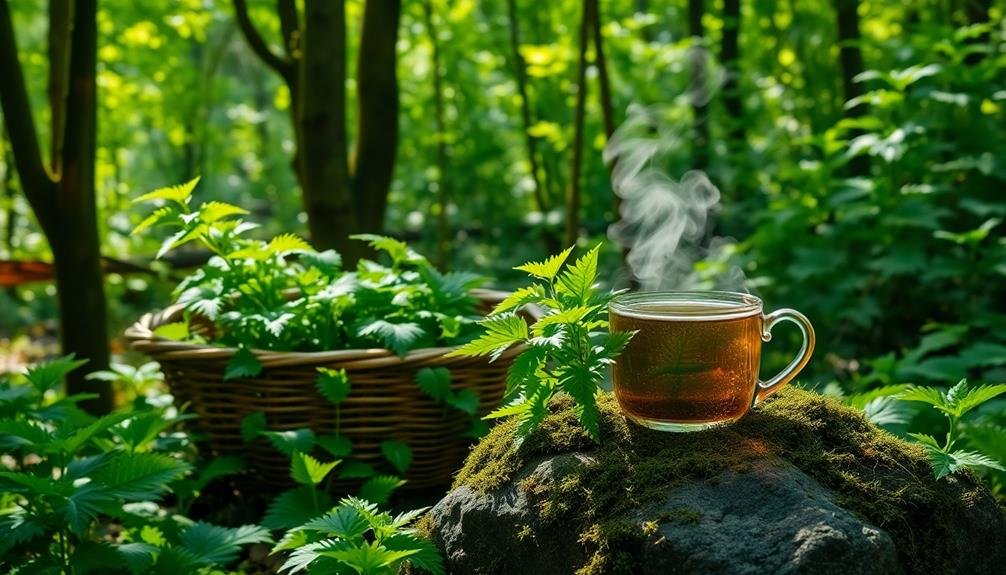
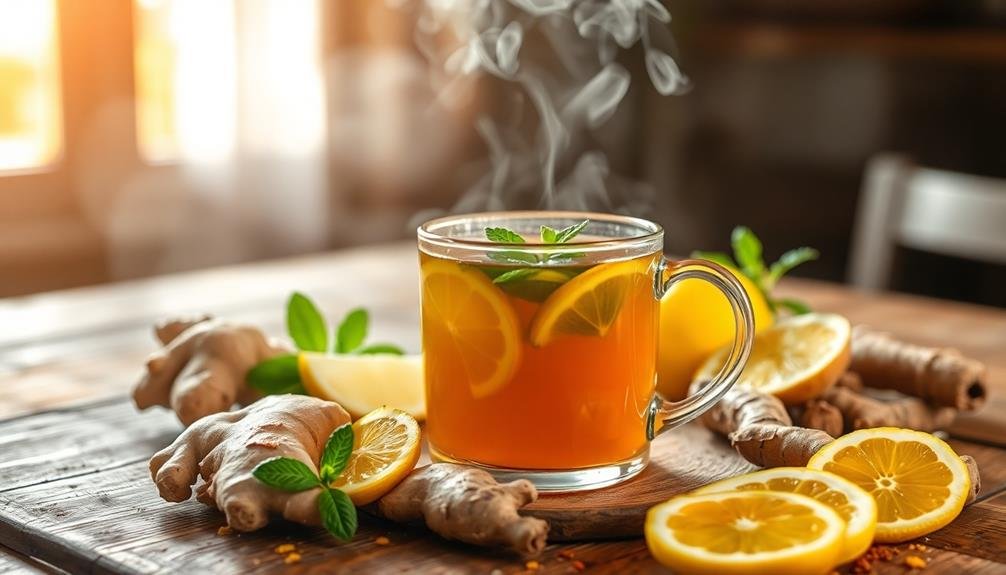
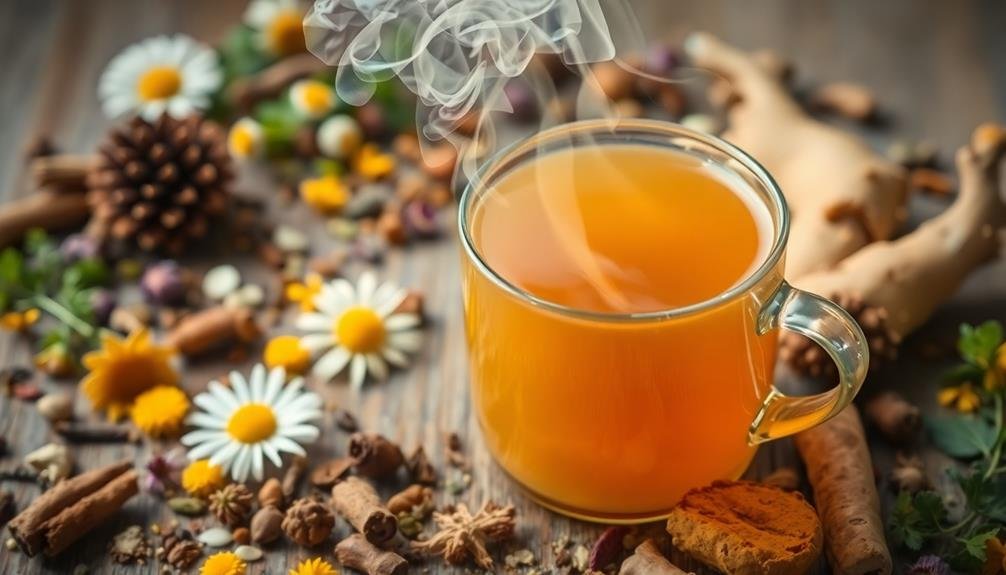
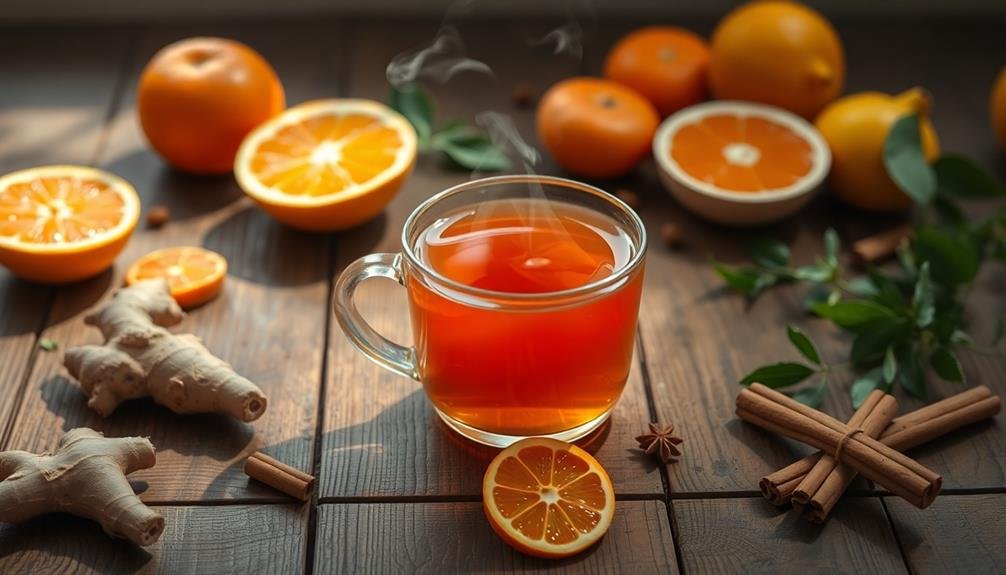
Leave a Reply